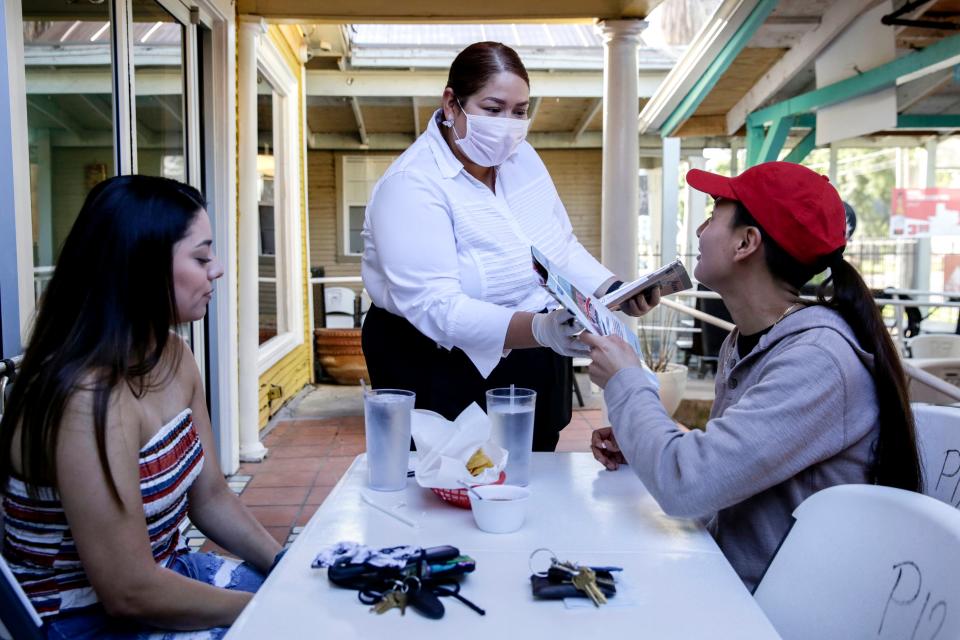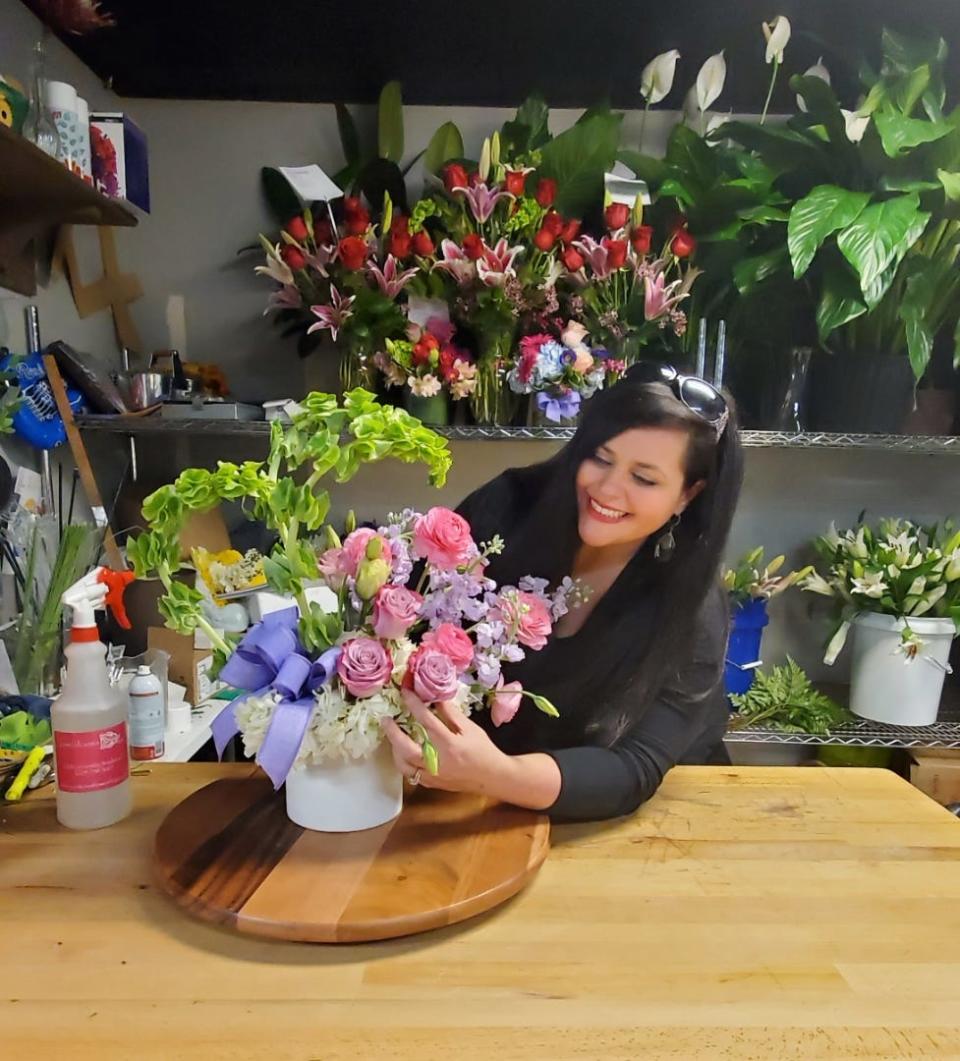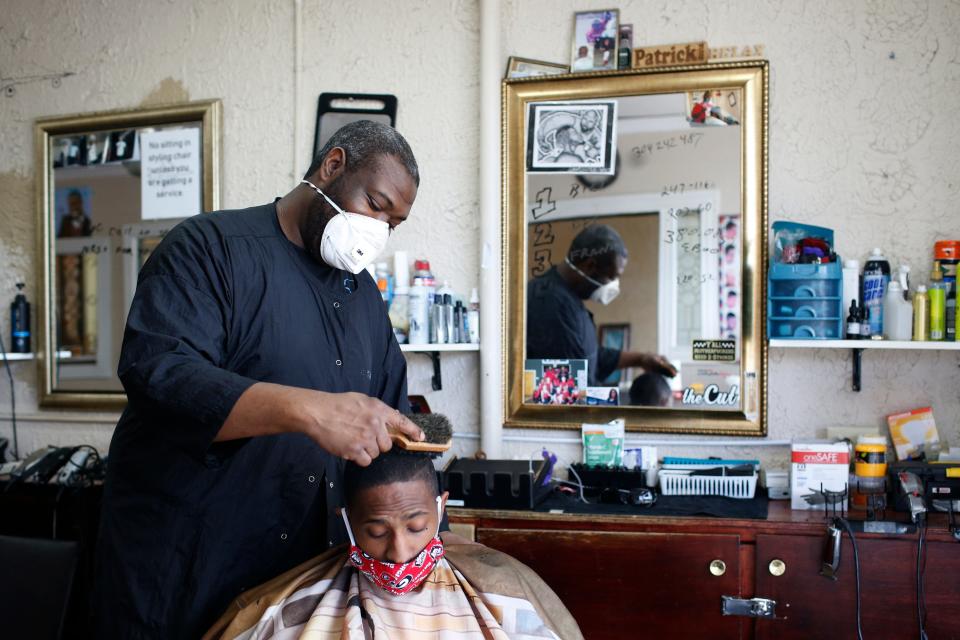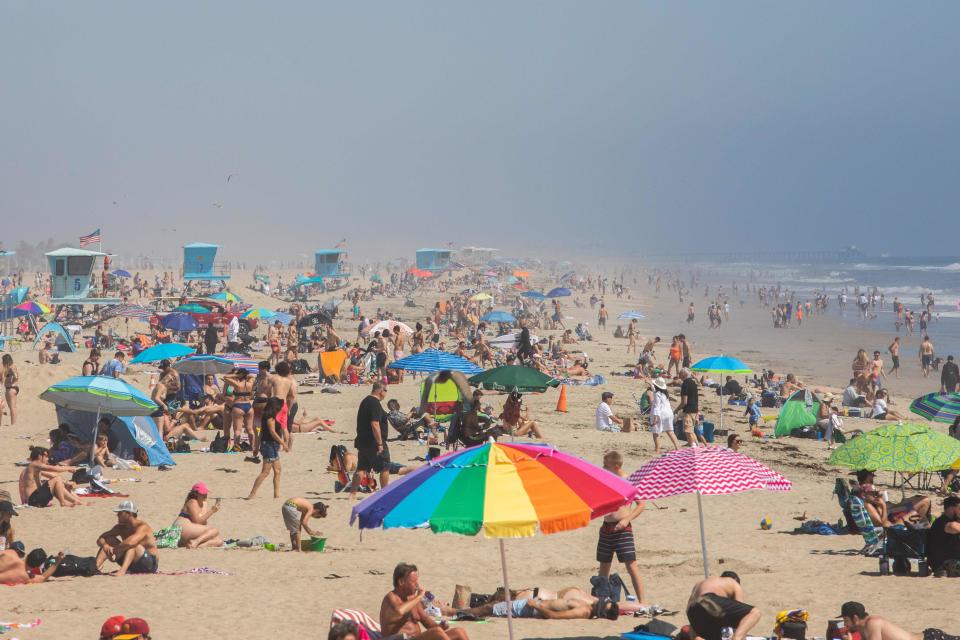Across US, a 'tale of two cities' as some embrace reopening amid coronavirus and others remain wary
SAN FRANCISCO – The nation's disjointed approach to reopening has revealed two Americas.
One is populated by those eager to reclaim freedom of movement and restart the economy, and another by people whose COVID-19 concerns keep them sheltering in place. And often they’re living side by side in a country rocked by 1.2 million coronavirus cases and 75,000 deaths.
In California, which is reopening cautiously, Jeff Gourley has drawn both heat and praise for welcoming patrons to Nomads Canteen in San Clemente near San Diego.
“I’m not a fool, I’m not unsympathetic,” he says. “But we can’t quarantine the healthy anymore.”
Meanwhile in Georgia, where Gov. Brian Kemp has pushed for a faster opening, Atlanta public relations exec Jenny Moss isn’t ready to resume old habits.
“My response is pretty simple,” she says. “In the time between when lockdown began and where we are now, nothing has changed. So I'm taking precautions."
Coronavirus reopening: See a map of when states are ending lockdown

You can survey just about any U.S. city or town and find examples of both attitudes. Some are shaped by political beliefs, others by economic challenges and a comfort with risk. But despite disagreements over speed, the national reopening is happening.
A USA TODAY analysis of mobile phone use data shows that people in every state have become more active in recent weeks after a significant reduction in mobility that reached its lowest point in mid-April.
Graphics: See how quickly Americans hunkered down and compare states
But many Americans remain cautious. The data, which comes from location data company SafeGraph and is based on the recorded movements of 16 million anonymous phones, reveals the rebound is happening far more slowly than many states' abrupt move to shelter in place, with U.S. mobility less than halfway back from its lowest level when compared with February.
States also are not reopening at the same pace. The mobility data shows that the 10 states with the lowest leaving-home rates are on the West and East coasts, areas where some governors have been aggressive about self-quarantines.
Of those, seven are in the top 10 for total deaths, including hard-hit New York and New Jersey, where to date a combined 35,000 have died from COVID-19, the pulmonary complications from the virus.
In contrast, the seven states that are almost halfway back to normal movement are in the Plains and Southeast, where death counts have been lower and leaders often have been more hesitant to restrict movement and eager to resume commerce.
Health officials warn that getting back to some form of normal may not be without consequences. Officials are monitoring infection rates in case a restoration of shelter-in-place orders becomes necessary.
“It would be a massive miscalculation and a fundamental misunderstanding of the biology of the way this virus works to think we can jump back into our old lives,” says Larry Chang, infectious diseases specialist at Johns Hopkins University in Maryland.
Chang says a lack of national strategy on the reopening has left it to local officials to comes up with their own rules. But the mutating and contagious nature of the coronavirus will continue to pose a threat if group contact is reinitiated too soon.
“Is there a community where people don’t get the flu? No,” he says. “Some parts of the country may feel that this virus hasn’t or can’t or won’t affect them, but the virus will find them.”
Survey: Americans more worried about reopening too quickly than not opening quickly enough
More 'Trump' states are opening for business
Political leanings are proving to be a factor when it comes to regions ditching a stay-at-home existence, according to researchers at Stanford University in California, whose study found a persistent partisan divide among those following social distancing guidelines.
“People in the most pro-Trump counties had reduced their visits to nearby points of interest down to about 42%, whereas that number was 64% in less ‘Trumpy’ places,” says Stanford graduate student Levi Boxell, who worked on the research.
Boxell says people seem to be basing their decisions less on government orders and more on a mix of risk perception and economic incentives.

USA TODAY’s analysis confirms that residents of counties and states that voted most heavily for President Donald Trump in 2016 left home more frequently than others during peak quarantine and are now closer to returning to pre-COVID-19 levels of activity.
Lindy Thompson owns the Sage Matt Café in the north Texas panhandle town of Miami, a hub of the nation’s most pro-Trump county, where the president garnered 95% of the vote in 2016.
Texas has 1,100 coronavirus-related deaths. People in Miami and the surrounding Texas county are just shy of halfway back to February levels of activity from April’s low, USA TODAY’s analysis found.
Although Thompson, 39, reopened her eatery on the day Gov. Greg Abbott allowed it on May 1, she says the shelter-in-place orders are “not a red or blue issue here. People took it seriously even though we’re rural.”
Her customers are slowly coming back, though takeout is still popular. To stay safe, tables are 6 feet apart and no condiments can be shared.
"And I'm OCD about my cleaning," she says.
What are the social distancing rules in my state? Access to restaurants, retail and outdoor activities is on the rise
In Tuscaloosa, Alabama, another Trump stronghold, florist Sarah Morrison, 33, recently reopened her Tuscaloosa Flower Shoppe in time for Mother’s Day. She has brought back most of her employees, and so far business is looking brisk.
Morrison doesn’t consider herself political, but she says she does appreciate the president “leaning toward states deciding for themselves, because it’s different here than New York.”
Alabama has had 350 coronavirus deaths. In Tuscaloosa County, 75% of phone users left home during the seven days ending May 1, a little shy of the 82% who did so in February.

The big concern in town, as always, is football, and many are worried about the economic impact if the University of Alabama’s fabled Crimson Tide does not play this fall.
“We can’t quit living out of fear of the virus, but we’re holding our breath on football,” Morrison says.
Back to business, but with masks
Other snapshots from around the nation speak to that same blend of excitement and circumspection about emerging from coronavirus restrictions.
In Roswell, Georgia, Mikaela Cupp, general manager at Hugo’s Oyster Bar, has been happy to see friends and neighbors return to the restaurant, even if they’re sitting 6 feet apart. Her staff all wear masks even if patrons mostly are not. More than 1,300 Georgians have died from COVID-19.
“The community’s excited, there’s this pent-up ‘We want to get out of the house’ energy,” she says. “And people generally are still being very respectful, doing their part, keeping their distance.”
In Gulfport, Florida, Ester Venouziou is “pretending the governor said nothing” and is continuing to social-distance for the next few weeks, despite Gov. Ron DeSantis’ push to reopen eateries and beaches in the state where 1,600 have died to date.

“People on social media are busy criticizing choices,” says Venouziou, who promotes local businesses. “Some say ‘Let’s get the economy going and patronize stores,’ and others are saying ‘You’re greedy and don’t care about our health.’ Everyone is doing what they think is right, so it’s frustrating to see people attacked.”
Over in Highland, Michigan, Mike Maher never shut down Maher Feed & Pet Supply, given his goods were essential for the rural area’s livestock owners. Michigan has reported more than 4,300 coronavirus deaths.
“People mostly are being careful,” says Maher, whose employees wear masks and keep their distance.
He hasn't seen his mother in six weeks out of concern for her health. And the virus has taken its toll on fellow business owners.
“The neighborhood we live in is normally vibrant, but it’s been a ghost town. We’re worried for shops that remain shuttered,” he says.
Get daily coronavirus updates in your inbox: Sign up for our newsletter now.
In one town, 'tale of two cities'
The nation’s patchwork attitudes and approach to reopening – not just state by state but often county by county – has resulted in a bit of a societal free-for-all that sometimes has resulted in cavalier and even violent behavior.
Consider New York City, where despite a staggering death toll of 20,000, some young residents recently flocked to parks to bask in the spring sunshine and drew police in response.
Or the Michigan shopper who, after being asked to wear a mask, wiped his nose on the employee’s shirt before being arrested.
Or the Southern California beach towns that are in a heated tug-of-war with the state’s governor over access to that iconic surf.

“It’s almost a tale of two cities here in San Clemente,” says City Councilman Gene James. “You’ve got a vibrant group of younger people here for the beach life, and other, older residents who believe we should keep riding the shelter in place out.”
James says he sympathizes with both points of views but sides with those who want life to resume. California has more than 60,000 coronavirus cases and about 2,500 deaths.
“We mitigated the spread of the virus here by following all the rules, but my heart breaks for businesses being lost,” he says. “How long can we shelter in place?”
Humans fear virus, but also FOMO
Humans instinctively lean toward both a desire for normalcy and a tendency to follow group behavior, says Elissa Epel, professor of psychiatry at the University of California-San Francisco.
“Group-think is powerful for us humans,” Epel says. “If people are feeling low-risk and starting to go out to dinner, we have FOMO – fear of missing out. We want in.”
But, Epel notes, risk is a relative term. For some Americans, the risk of not getting back to the office is boredom, but for many it means the possibility of hunger and homelessness.
Statistics are showing that for some ethnic groups, specifically African Americans, Latinos and Native Americans, the risk of contracting COVID-19 comes with a significantly higher mortality rate, she says.
“We cannot fully understand the many predicaments and motivations people have” as the nation reopens, she says. “There are many different social, financial and political contexts that are driving the appearance of two Americas.”

The push to reopen is unfairly jeopardizing the most physically and financially fragile Americans, says the Rev. William Barber II, a celebrated pastor out of Goldsboro, North Carolina. He is co-chair of the Poor People’s Campaign, which has launched an initiative against reopening called “Stay in Place, Stay Alive, Organize.”
“Poor white people and poor black people are most at risk from this virus, and now governors want to send them into this lethal reopening,” Barber says. “It’s wrong and against the best medical advice.”
Denita Jones, 49, is back to work at a medical billing company in Dallas, but she’s nervous about it. Jones, who has asthma along with her two teenage children, is worried that her office setup continues to put her at risk for the virus.
“Three people in my office are wearing masks, out of maybe 75,” she says. “I see people congregating at cubicles. When I asked people to wear a mask when speaking with me, I got dismissive looks.”
Dallas County residents largely adhered to Texas' self-quarantine edicts over the past weeks, with only 56% leaving home at the low point in April, USA TODAY data showed. They’re now about one-third of the way back to their pre-COVID-19 level of activity.
For Jones, working is a necessity to put food on the table. Her city’s gradual push to return to normal makes her fearful.
“I see people going back to pre-pandemic behavior like everything’s OK in the world, and the rest of us are walking on eggshells,” she says.
Fears of a second COVID-19 wave
Recent reports indicate that models created by the Federal Emergency Management Agency forecast about 200,000 new cases each day by the end of May, a massive jump from the roughly 25,000 cases a day that have been the norm during the national lockdown.
Down in San Clemente, bar owner Gourley says no one will be watching those statistics more carefully than he will.
“I’m not a virologist, but I’m following our cases and death rates, and those low numbers here have encouraged me to reopen, and I’ll keep following them just as closely as before, every day,” he says.

About 50% of residents in Orange County, where San Clemente is located, left home during the height of quarantine back in April, device data showed. The level of activity has crept back just a quarter of the way to normal as of May 1.
Some of those revelers are coming to Nomads for cold beer and tasty Mexican food. Gourley says he has hired extra security to try to keep patrons adhering to social distancing guidelines both inside the eatery and on its deck.
The raucous scene at Nomads last weekend so resembled pre-virus times, with customers shoulder to shoulder, that police came to warn Gourley. He asked customers to distance, and most did.
More: Coronavirus may last 2 years, study warns. And its second wave could be worse.
Gourley says he is proud that out of concern for staff and customers he shut down Nomads days before California Gov. Gavin Newsom issued a statewide mandate on March 19. Newsom has gradually been issuing new guidelines for retail outlets as the state eases toward reopening.
But the San Clemente restauranteur says he decided weeks ago, based on the county's comparatively low death rates, that he would reopen on May 1 regardless of what Newsom decided. Given the circumstances, keeping the doors of Nomads closed was no longer a viable option, he says.
“I’m not underestimating this virus,” Gourley says. “But for me, the question was: How long do we wait? Is this virus going to be gone after six months, when we’re all broke? We have to live and move on.”
Follow USA TODAY Network reporters Marco della Cava @marcodellacava, Dan Keemahill @dankeemahill, Nick Penzenstadler @npenzenstadler and Mike Stucka @mikestucka. Contributing: News developer Dak Le.
ABOUT THE NUMBERS: For its analysis, USA TODAY used data on cell phone usage from SafeGraph. The analysis measured the share of users in each state and county who left home on a typical day in February, before the crisis, how many left home during the state’s lowest level of activity, and how many were on the move during the seven-day period ending Friday. From that, the news outlet calculated which states are closest to returning to normal levels of mobility. To account for variations by day of the week, the analysis used seven-day averages.
This article originally appeared on USA TODAY: Coronavirus reopening: Americans still afraid to go outside, data show

